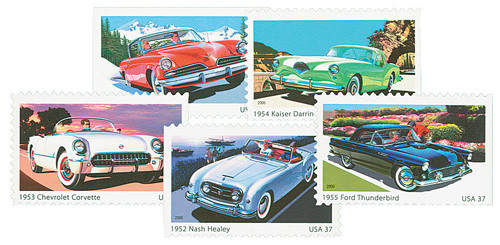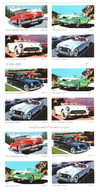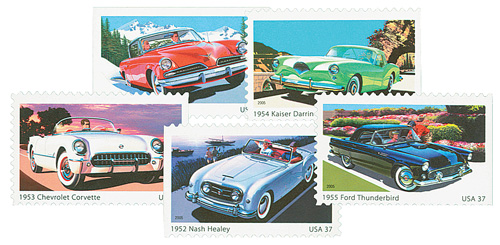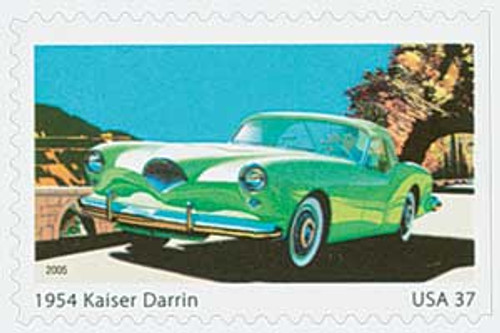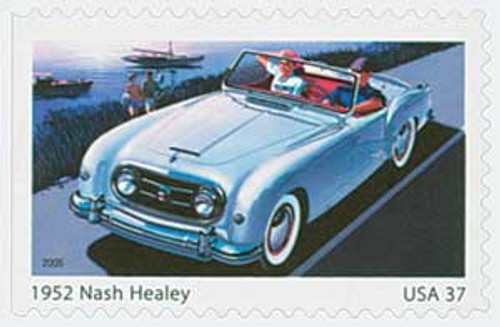
# 3931-35 - 2005 37c Sporty Cars
37¢ America on the Move
Booklet Stamps
City: Detroit, MI
Printing Method: Lithographed
Color: Multicolored
America On The Move Series
Automobiles of all sorts have been featured on US stamps for years. One of the first US stamps to picture an automobile was US #296, issued for the Pan-American Exposition. The stamp pictured an early electric automobile used for passenger service by the Baltimore and Ohio Railroad.

Since then, the USPS issued dozens more stamps honoring cars – from antique vehicles of the 1800s to early electric autos to the stylish cars of the mid-1900s. Cars have long been a popular topic on stamps, so in 2005, the USPS introduced a new series honoring the stylish cars of the 50s, 60s, and 70s – America on the Move.
The first stamps in the series honored 50s Sporty Cars – the 1953 Chevrolet Corvette, 1954 Kaiser Darrin, 1952 Nash-Healey, 1953 Studebaker Starliner, and the 1955 Ford Thunderbird. The stamps were dedicated at the Michigan State Fair in Detroit on August 20, 2005. During the ceremony, the deputy postmaster general proclaimed, “Automobiles have always been a clever way of celebrating our American history and culture. These cars are a perfect reminder of the 1950s and America’s optimism that the nation’s future was looking bright.”
The stamps were designed by Carl Herman and their artwork was provided by Art Fitzpatrick. Fitzpatrick had previously been an advertising designer and illustrator for General Motors. He also designed the Packard four-door convertible and hardtop sedans when he was only 20 years old. Additionally, he built custom cars for notable entertainers Clark Gable, Errol Flynn, and Al Jolson.

The second set of stamps in the America on the Move Series was issued on October 3, 2008, at the Fall Carlisle Collector Car Swap Meet and Corral in Carlisle Pennsylvania. The set, titled “50s Fins and Chrome,” pictured a 1957 Chrysler 300C, a 1957 Lincoln Premiere, a 1957 Pontiac Safari, a 1957 Studebaker Golden Hawk and a 1959 Cadillac Eldorado.

Speaking about the stamps, which were again illustrated by Fitzpatrick, a USPS representative said, “Automotive history is brilliantly illustrated on these awesome stamps. We are proud to feature these classic cars on stamps here at the mecca of car shows.” Flamboyant tail fins and shiny chrome accents were hallmarks of the 1950s cars that heralded the dawn of the space age in America.
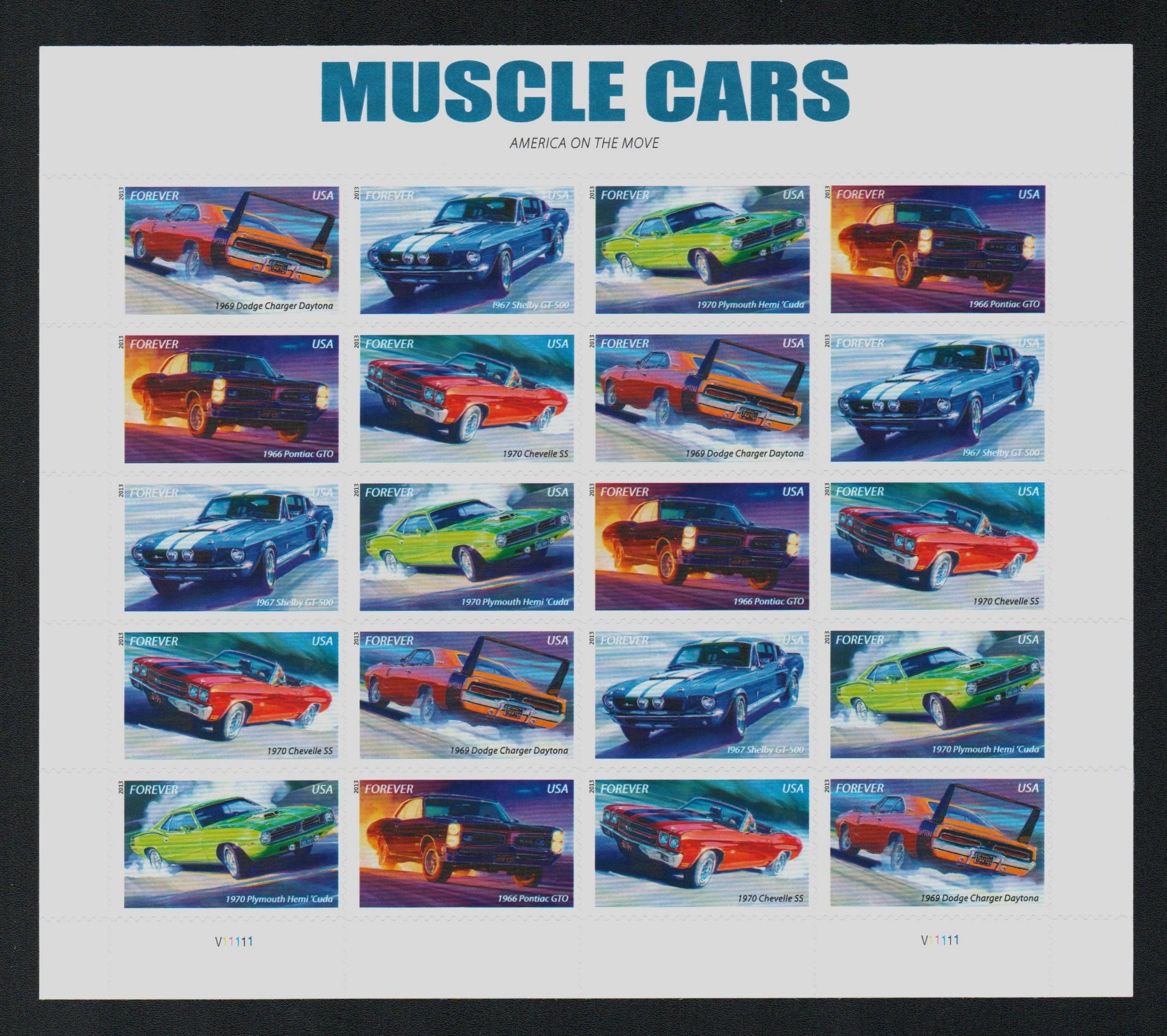
The third set of stamps in the series, titled “Muscle Cars,” was issued on February 22, 2013, at the Daytona International Speedway – two days before the Daytona 500. The stamps, with art by Tom Fritz, pictured the 1966 Pontiac GTO, 1967 Shelby GT-500, 1969 Dodge Charger Daytona, 1970 Plymouth Hemi ”˜Cuda, and 1970 Chevelle SS.

In speaking about the stamps, the USPS said, “The Muscle Cars stamps celebrate an exciting era in American automotive history. Typically equipped with big, powerful engines, these high-performance vehicles first roared onto our roads in the 1960s. Raw power has a stamp of its own, and these limited edition stamps feature five iconic muscle cars.”
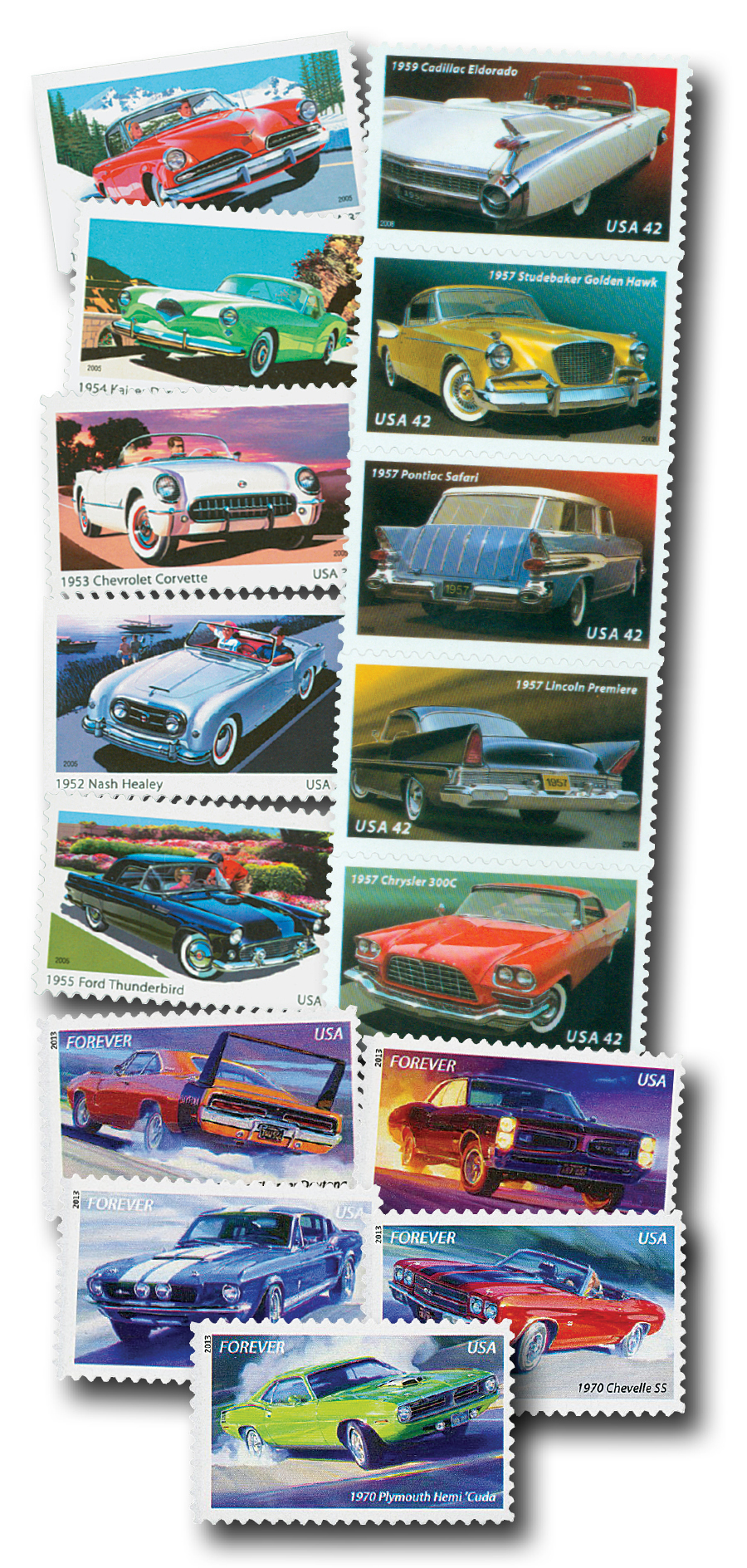
Click here for lots more car stamps.
37¢ America on the Move
Booklet Stamps
City: Detroit, MI
Printing Method: Lithographed
Color: Multicolored
America On The Move Series
Automobiles of all sorts have been featured on US stamps for years. One of the first US stamps to picture an automobile was US #296, issued for the Pan-American Exposition. The stamp pictured an early electric automobile used for passenger service by the Baltimore and Ohio Railroad.

Since then, the USPS issued dozens more stamps honoring cars – from antique vehicles of the 1800s to early electric autos to the stylish cars of the mid-1900s. Cars have long been a popular topic on stamps, so in 2005, the USPS introduced a new series honoring the stylish cars of the 50s, 60s, and 70s – America on the Move.
The first stamps in the series honored 50s Sporty Cars – the 1953 Chevrolet Corvette, 1954 Kaiser Darrin, 1952 Nash-Healey, 1953 Studebaker Starliner, and the 1955 Ford Thunderbird. The stamps were dedicated at the Michigan State Fair in Detroit on August 20, 2005. During the ceremony, the deputy postmaster general proclaimed, “Automobiles have always been a clever way of celebrating our American history and culture. These cars are a perfect reminder of the 1950s and America’s optimism that the nation’s future was looking bright.”
The stamps were designed by Carl Herman and their artwork was provided by Art Fitzpatrick. Fitzpatrick had previously been an advertising designer and illustrator for General Motors. He also designed the Packard four-door convertible and hardtop sedans when he was only 20 years old. Additionally, he built custom cars for notable entertainers Clark Gable, Errol Flynn, and Al Jolson.

The second set of stamps in the America on the Move Series was issued on October 3, 2008, at the Fall Carlisle Collector Car Swap Meet and Corral in Carlisle Pennsylvania. The set, titled “50s Fins and Chrome,” pictured a 1957 Chrysler 300C, a 1957 Lincoln Premiere, a 1957 Pontiac Safari, a 1957 Studebaker Golden Hawk and a 1959 Cadillac Eldorado.

Speaking about the stamps, which were again illustrated by Fitzpatrick, a USPS representative said, “Automotive history is brilliantly illustrated on these awesome stamps. We are proud to feature these classic cars on stamps here at the mecca of car shows.” Flamboyant tail fins and shiny chrome accents were hallmarks of the 1950s cars that heralded the dawn of the space age in America.

The third set of stamps in the series, titled “Muscle Cars,” was issued on February 22, 2013, at the Daytona International Speedway – two days before the Daytona 500. The stamps, with art by Tom Fritz, pictured the 1966 Pontiac GTO, 1967 Shelby GT-500, 1969 Dodge Charger Daytona, 1970 Plymouth Hemi ”˜Cuda, and 1970 Chevelle SS.

In speaking about the stamps, the USPS said, “The Muscle Cars stamps celebrate an exciting era in American automotive history. Typically equipped with big, powerful engines, these high-performance vehicles first roared onto our roads in the 1960s. Raw power has a stamp of its own, and these limited edition stamps feature five iconic muscle cars.”

Click here for lots more car stamps.

